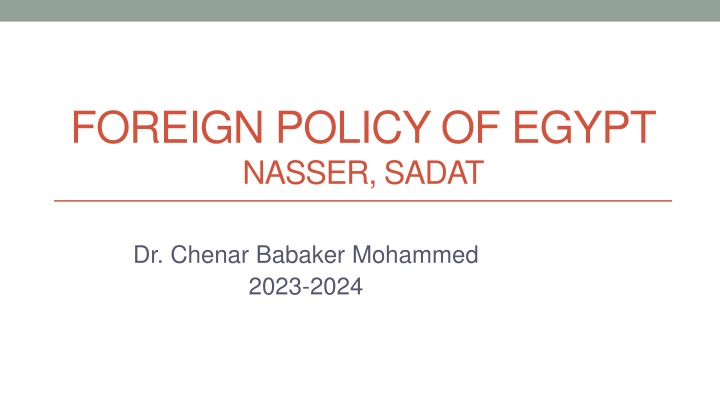
Egyptian Foreign Policy Evolution: Nasser to Sadat Era
Explore the evolution of Egyptian foreign policy from the Nasser era to the Sadat period, focusing on the Arab-Islamic, African, and Western dimensions that shaped the country's diplomatic relationships. Discover how Egypt's strategic alliances shifted in response to global dynamics and regional leadership aspirations.
Download Presentation

Please find below an Image/Link to download the presentation.
The content on the website is provided AS IS for your information and personal use only. It may not be sold, licensed, or shared on other websites without obtaining consent from the author. If you encounter any issues during the download, it is possible that the publisher has removed the file from their server.
You are allowed to download the files provided on this website for personal or commercial use, subject to the condition that they are used lawfully. All files are the property of their respective owners.
The content on the website is provided AS IS for your information and personal use only. It may not be sold, licensed, or shared on other websites without obtaining consent from the author.
E N D
Presentation Transcript
FOREIGN POLICY OF EGYPT NASSER, SADAT Dr. Chenar Babaker Mohammed 2023-2024
content Introduction to Egypt Foreign policy Foreign policy in Nasser era FP of Anwar Sadat FP of Hosni Mubarak
Introduction to Egyptian foreign policy Foreign policy of Egypt has historically been based on three pillars: First :Arab-Islamic Dimension Second: African Dimension Third: Western Dimension
First :Arab-Islamic Dimension Egypt as a regional leadership with the foundation of the Arab Republic of Egypt in the second half of the 20th century Nasser role as an elder brother role in the Middle East
Second: African Dimension With the effect of this new leadership, Nasser managed to enrich his African policy with a high-level of anti-colonial and anti-imperialist political discourse among the newly- independent African states as a result of the de- colonization process of the time in the global politics
Western Dimension Geopolitically including the Mediterranean World culturally and historically being a Westerner has always effected the identity of the country
Western-centered foreign economic aids also meant the preservation of the power in domestic politics, the Egyptian foreign policy decision-makers of Sadat and Mubarak preferred to strengthen the Western dimension to preserve the regional leadership of their country and the continuation of their power in domestic politics.
global balance of power in the Middle East of the 1970s, when the Cold War entered the period of D tente, Egypt began to adopt a more Western-centered foreign policy in the period of Anwar Sadat. This preference of Egypt turned into a one- dimensional Westernism centered on the U.S. in the 1980s, when the outcome of the Cold War began to be evident.
As a matter of fact, the Western-centered foreign policy, as started Camp David process during the period of Sadat, made Egypt one of the most reliable allies of the U.S. in the Middle East since the end of the Cold War.(Bilgenoglu, 2020)
FP of Egypt in Nasser Era Nasser was first Egyptian ruler who established the foundation of independent foreign policy in Egypt, because before his rule, Egypt was under the British domination. 1954, the British influence was ended, and led the new emergence of Egypt influential political actor in the world horizon.
Nasser adopted an anti-West approach due to western imperialist policies. Egypt focused on strengthening its armed forces to counterbalance Israel's military might. (Khawaja, 2013: 44)
anti-imperialism: Nasser s anti-imperialist values had been reinforced by the United States and Great Britain s refusal of the Nasser s demands for advanced weapons. Nasser could break the Western weapons monopoly and embargo by making a weapon deal with Czechoslovakia in 1955.
Hinnebusch claims that this deal consolidated Nasser s anti-imperialist and independency oriented values by endorsing the availability of other power centers rather than western ones in international affairs and by eliminating Egypt s dependence on imperialist forces.(Hinnebusch,2003)
Project of Aswan High Dam in 1956: consolidated the anti-Imperialist of Nasser values: This foreign control was rejected by Nasser and his response was to nationalize the Suez Canal and claim the transit dues to finance the Dam.
Thus the Suez Crisis and subsequently the announcement of the Eisenhower Doctrine by the US in 1957 to form an anti-Nasser block in the region and to implement the western plans of the Baghdad Pact consolidated Nasser s anti- imperialist value as a growing variable in making anti-West Egyptian foreign policy (EFP). (Dawisha, 1976)
Military might: Egypt in the case of strengthening military ties, it gave preference to Soviet Union over U.S. and it rejected the US supplying weapon and instead make treaty with Soviet Union.
Economic strengthening: Egypt signed trade pacts with Romania, Hungary, East Germany and China. The fear of U.S for tie of Egypt to Soviet, they came up to assist Egypt for the Aswan High dam on the Nile river. But due to mistrust to west this plan was defeated.
Then USSR took that opportunity to pledge the finance the dam. But the US withdraws from its financial assistance, as a consequence, the domestic pressure on Nasser, and emerging of nationalist aspiration, Nasser make the Anglo- French Suez Canal company which have been made between Britain and Egypt.
But later France and Britain used Israel as frontline state to attack Egypt. Then under the pressure of U.S to make ceasefire between them. Because U.S. didn t want the control of the USSR on Egypt.
Egypt agreed to open the canal and Britain agreed to pay the toll in pounds sterling. The frozen funds have been released and Israel had to withdraw its troops from the Sinai Peninsula and deploy the United Nations Emergency Force (UNEF) there.
Although after the Suez Canal crisis, Nasser became a hero in the Arab world and a key figure in Middle Eastern Under Eisenhower Doctrine, the United States began providing Israel with highly advanced and sophisticated weapons.
Unified military command with Arab league 1964, with Syria, 1966, jointly defend command with Jordan in 1967. UNEF troop withdraws after Nasser request.
Nasser after the ceasefire of Suez crises, he became a hero in the Arab world. and then the anti-western
Resolution of 242 for ceasefire, and there are the shortcoming of the Nassir foreign policy. The first, Egyptian military intervention in the Yemen drained Egypt financially. Second, when UNEF withdrew, they large Egyptian supplying army was costing a lot and the chaos in administrative make it difficult. And it relied on Soviet war with Israel,
In the other hand the resolution of 242, for cease-fire didn t force Israel to withdraw from the occupied area like Sinai. And it made the fortification along the Bar Lev Line. Then Nasser wanted to regain the lost area, and start the war of attrition which lasted from July 1967 to August 1970.
Under the Sadat rule: He soon realized that the restoration of Egypt's political position, after defeat in the 1967 war, could not be achieved without US support. in the 1970s, the US made a dramatic policy shift and launched d tente and rapprochement with the Soviet Union.
Under that policy, both superpowers signed disarmament treaties, for instance, Strategic Arms Limitations Talks (SALT) and Anti- Ballistic Missile Treaty (ABMT).( Mark, 1995)
After the defeat of Nasser in 1967 and the reconciliation between superpowers, Sadat believed that to resolve all the problem it needs to be closed to the US. and the burden of security in border it costs a lot for Egypt, and it cost 25 percent of the Egypt GDP Sadat knew that the country which can ease the problem is America.(Jeremy, 2008)
Revolution of Rectification The reconciliation between the superpowers had a major impact on Middle Eastern politics and prompted Egypt to reassess its relationship with the Soviet Union. Sadat realized that the military dependence of the Soviet Union would no longer work. Therefore, in order to create a good image for in the West, he carried out internal reforms.
violated Nasser's policy. These reforms include the reintegration of the multi-party system and a liberalized economic system. He called his reform strategy the "Revolution of rectification These measures have been widely praised by West. Yom Kippur war, In 1973 a decisive attack by Egypt and Syria on Israel, Egypt attacked west bank and Syria attacked north. It was ended by UN intervention.
Why Arab league under the role of Saudi declared the oil embargo? Because they wanted to put pressure on U.S to change it pro-Israeli policy. So Anwar Sadat succeeds into shock the Israel and the rest of the world by its oil embargo
What is Shuttle diplomacy? Henry Kissinger, under such diplomacy The war and the oil embargo prompted the United States to seek a permanent solution to the conflict in the Middle East. Henry Kissinger, then US Secretary of State, fought for reconciliation between Israel and Egypt under shuttle diplomacy.
As a result, Egypt resumed its relations with the United States that had been severed after the 1967 Arab-Israeli War. After three years of great diplomatic efforts by the United States, Egypt and Israel signed a peace treaty in 1979.
The Camp David Peace Accords, the Sinai Peninsula was returned to Egypt, and the Suez Canal was opened to Israel. In this way, Sadat achieved two foreign policy goals: rebuilding relations with the United States and ending the security threat from Israel
Although it ushered in a new era of US financial support for Egypt, it isolated Egypt from the Arab world. Egypt lost its membership in the Arab League, and Sadat was called a traitor. The rebuilding of relations with the United States has greatly helped Egypt to promote.
Hosni Mubarak He rejected US pressure to take joint military action against Libya in 1985 and 1986. He also played a leading role in African economic integration and joined the Common Market for Eastern and Southern Africa (COMESA) in 1998. (Asif, 2011)
Hosni Mubarak had the passive policy toward Israel and tried to brokered between both Israel and Palestine. After the Iranian revolution the Arab states look at Egypt to counterbalance Iran. And in other hand, Mubarak supported the Mujahidin in Afghanistan against Soviet.
The differences with U.S emerged in 2008 when us under the policy of promotion democracy pressured on Mubarak to take the domestic reforms. And later after uprising US supported protests and the change in Egypt.
The change is regarded as a turning point in Egyptian history; After uprising 2011 and the rise of Muslim Brotherhood of Islam, Mohammed Morsi became the country's first democratic ruler. The change is regarded as a turning point in Egyptian history, because the oldest Islamic organization successfully overthrew the 30-year-old Hosni Mubarak regime and turned to support the West.
This change seems to repeat the history of this country with outstanding rulers and their systems. In 1952, the military commander GamalAbdul Nasser launched the Free Officers Movement against the then pro-British King Farouk I. He practiced a military dictatorship that lasted for 60 years (Khawaja, 2013).
References Khawaja,Nur aluin, Egypt's Foreign Policy Analysis: From Nasser to Morsi Pakistan Institute of International Affairs, Vol. 66, No. 1/2 (January-April 2013), pp. 43-6 Bilgenoglu, Ali Revisiting the 20th Century Egyptian Foreign Policy: Pillars, Concepts and Decision-Making the Geopolitics, Spetember 19, 2020 Raymond A. Hinnebusch, The International Politics of the Middle East (Manchester University Press, 2003), 24. Dawisha, Egypt in the Arab World: The Elements of Foreign Policy, Halsted Press, 127 128. Asif Haroon Raja, 'Egypt under Anwar al-Sadat and Ilosni Mubarak (1970- 2011)',Asian Tribune, 6 March 2, 2011 Mark R. Amstutz, International Conflict and Cooperation: An Introduction to World Politics (Madison: Brown & Benchmark, 1995), p. 128 Jeremy M. Sharp, 'Egypt: Background and US Relations', CRS Report for the Congress, 12August 2008 p 5






















